Paincast
Paincast is an effort of the Pain Science Division at the Canadian Physiotherapy Association. Paincast brings together researchers, clinicians, and students to facilitate knowledge translation, discussion, and critical thinking on topics related to pain and physiotherapy. The views expressed in each episode are of individual guests, do not constitute medical advice, and do not represent the views of the Pain Science Division or the Canadian Physiotherapy Association. Follow us on Instagram @paincast.psd. While there is an effort to incorporate research evidence in the episodes, and the topic is researched by the host, we recognize there is room for improvement and there is expertise in the community. As such, we invite constructive critique and that you inform us of any inadvertent errors, so that we may correct them. You may submit feedback through this form: https://forms.gle/BQ4KymfsCuTSFGaX7. You may contact Tiffany Tiu at paincast.psd@gmail.com if you have any other inquiries.
Episodes

5 days ago
5 days ago
This episode is produced during the 2025 World Physiotherapy Congress in Tokyo, Japan. I interviewed physiotherapists around the world about pain.
Content:
(00:01:59) Nicola - United Kingdom(00:11:54) Helen - Switzerland(00:18:52) Mio - Japan(00:20:23) Edgar - Columbia(00:30:28) Marcia - Canada(00:43:31) Rosi & Leila - Indonesia(00:45:07) Nirit - Israel(00:52:56) Mike Landry - World Physiotherapy President
Episodes 8 and Episode 25 are also interviews with clinicians about pain. They are recorded during the Canadian Physiotherapy Association Congresses in 2023 and 2024.
Mike Landry also spoke about World Physiotherapy in Episode 28.
Paincast is dedicated to bringing together researchers, clinicians, and students to discuss topics related to pain and physiotherapy. The primary purpose is to facilitate knowledge translation and critical thinking. Some episodes posit themselves as more educational than others, and some more opinionated than others. The listener is encouraged to listen critically. While there is an effort to incorporate research evidence, and the topics are always researched by the host, we recognize there is room for improvement and there is expertise in the community. As such, we invite constructive critique and that you inform us of any inadvertent errors, so that we may correct them. You may submit your feedback through this form: https://forms.gle/UFfbUHBh8uKwSKgS8
Follow Paincast on Instagram: https://www.instagram.com/paincast.psd/
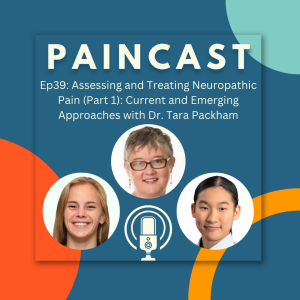
Tuesday May 27, 2025
Tuesday May 27, 2025
In this episode, we talked about:
Non-pharmacological management options for neuropathic pain
All about the Somatosensory Pain Rehab method
The current research on Somatosensory Pain Rehab
Dr. Tara Packham is an occupational therapist with over 25 years of clinical experience in hand and upper limb rehabilitation, and an assistant professor in the School of Rehabilitation Sciences (SRS) at McMaster University. Tara’s program of research focuses on assessing and addressing persistent pain, and continuing to advance the field of hand rehabilitation. Tara has published and presented extensively for both hand rehabilitation and pain management audiences on persistent pain conditions impacting the upper extremity. Her research spans development and evaluation of outcome measures, refining and testing interventions, and exploring the experiences of persons with health challenges accessing rehabilitation. She is the Editor in Chief at Hand Therapy and currently serves on the editorial boards of the Journal of Hand Therapy and Pain Medicine, and on the executive of the Complex Regional Pain Syndrome Special Interest Group at the International Association for the Study of Pain.
Resources
Patient support groups for CRPS: Canada - PARC: Promoting Awareness of RSD and CRPS in Canada https://www.rsdcanada.org/parc/english/index.html / USA - RSDSA https://rsds.org/
Packham, T. L., Spicher, C. J., MacDermid, J. C., Michlovitz, S., & Buckley, D. N. (2018). Somatosensory rehabilitation for allodynia in complex regional pain syndrome of the upper limb: A retrospective cohort study. Journal of Hand Therapy, 31(1), 10-19.
Somatosensory Pain Rehabilitation Network: https://www.neuropain.ch/en/home
Hebert, A., MacDermid, J., Harris, J., & Packham, T. (2024). How should we treat painful sensitivity in the hand? An international e-Delphi study. Journal of Hand Therapy, 37(1), 12-21.
Shafiee, E., MacDermid, J., Packham, T., Grewal, R., Farzad, M., Bobos, P., & Walton, D. (2023). Rehabilitation interventions for complex regional pain syndrome: an overview of systematic reviews. The Clinical Journal of Pain, 39(9), 473-483.
Social Media
X: @TaraLPackham
LinkedIn: https://www.linkedin.com/in/tara-packham-21918924/
IMPRinT lab: https://painmovementresearch.healthsci.mcmaster.ca/
Paincast is dedicated to bringing together researchers, clinicians, and students to discuss topics related to pain and physiotherapy. The primary purpose is to facilitate knowledge translation and critical thinking. Some episodes posit themselves as more educational than others, and some more opinionated than others. The listener is encouraged to listen critically. While there is an effort to incorporate research evidence, and the topics are always researched by the host, we recognize there is room for improvement and there is expertise in the community. As such, we invite constructive critique and that you inform us of any inadvertent errors, so that we may correct them. You may submit your feedback through this form: https://forms.gle/UFfbUHBh8uKwSKgS8
Follow Paincast on Instagram: https://www.instagram.com/paincast.psd/
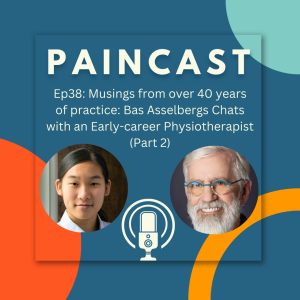
Saturday May 10, 2025
Saturday May 10, 2025
In this episode, we talked about:
A shift in how we think about the role of our hands as our understanding of pain science and patient science evolve
Discussing and addressing patient expectations for physiotherapy
Advice for physiotherapists, new and experienced
Graduated in 1983, Bas has extensive post-graduate experience in manual, exercise and movement focused therapies, sports physiotherapy and pain related education. He was a Mentor for post-graduate physiotherapists for the Pain Sciences Division of the Canadian Physiotherapy Association, and has been Team Therapist for the Junior National Figure Skating Team and the National Cross-Country Ski Team, and attended many National, World and Olympic competitions of a wide variety of sports. He has taught workshops in North America to Osteopaths, Medical Doctors and Physiotherapists since 1992. Sebastian will never stop learning. He enjoys his attempts at golf, loves travelling and being with friends and family.
Exploring Pain: Research and Meaning Facebook Group: https://www.facebook.com/groups/ExplainingPainScience
Paincast is dedicated to bringing together researchers, clinicians, and students to discuss topics related to pain and physiotherapy. The primary purpose is to facilitate knowledge translation and critical thinking. Some episodes posit themselves as more educational than others, and some more opinionated than others. The listener is encouraged to listen critically. While there is an effort to incorporate research evidence, and the topics are always researched by the host, we recognize there is room for improvement and there is expertise in the community. As such, we invite constructive critique and that you inform us of any inadvertent errors, so that we may correct them. You may submit your feedback through this form: https://forms.gle/UFfbUHBh8uKwSKgS8
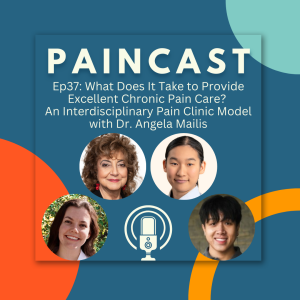
Tuesday Apr 29, 2025
Tuesday Apr 29, 2025
In this episode, we talked about
The systemic challenges in Ontario’s healthcare system and pain management
The importance of a quality interdisciplinary team for the benefit of the patient
What it takes to create a successful high-quality patient-centred interdisciplinary team
Dr. Angela Mailis obtained her medical degree from the Medical School of Kapodistriakon University of Athens Greece Summa Cum Laude; became a Fellow of the Royal College of Physicians of Canada with specialization in Physical Medicine (1982); and holds a Master’s degree from the Institute of Medical Science, University of Toronto (1988). She rose to the rank of Full Professor at the Faculty of Medicine, University of Toronto (2005) and has practiced exclusively in the area of Chronic Pain for the past 43 years. She founded and directed the Comprehensive Pain Program of the Toronto Western Hospital/University Health Network for 33 years (1982-2015). Subsequently she became the founder and director of the Pain and Wellness Centre in Vaughan, Ontario (2014-present), the only academic community-based pain clinic, funded by the Ontario Ministry of Health.
Resources
The Pain & Wellness Centre website: https://thepwc.ca/
Dr. Angela Mailis’s website: https://drangelamailis.com/
Pain & Wellness YouTube Channel: https://www.youtube.com/@PainAndWellnessCentre
Power Over Pain: https://poweroverpain.ca/
Mailis, A., & Lakha, S. F. (2019). From (Ontario Ministry of Health and Long-Term Care) policy to implementation: a retrospective look at a community-based patient-centered model of care for chronic pain. Canadian Journal of Pain, 3(1), 114-125.
Mailis, A., Deshpande, A., & Lakha, S. F. (2022). Long term outcomes of chronic pain patients attending a publicly funded community-based interdisciplinary pain program in the Greater Toronto area: results of a practice-based audit. Journal of Patient-Reported Outcomes, 6(1), 44.
Lakha, S. F., Hapidou, E. G., Robinson, J., & Mailis, A. (2022). Comparison of motor vehicle accident (MVA) survivors and non-MVA pain patients attending an interdisciplinary pain management program. Psychological Injury and Law, 15(4), 385-394.
Social media
Facebook: https://www.facebook.com/painandwellnesscentre/
Instagram: https://www.instagram.com/painandwellnesscentre/
LinkedIn: https://www.linkedin.com/company/thepwc/?viewAsMember=true
Paincast is dedicated to bringing together researchers, clinicians, and students to discuss topics related to pain and physiotherapy. The primary purpose is to facilitate knowledge translation and critical thinking. Some episodes posit themselves as more educational than others, and some more opinionated than others. The listener is encouraged to listen critically. While there is an effort to incorporate research evidence, and the topics are always researched by the host, we recognize there is room for improvement and there is expertise in the community. As such, we invite constructive critique and that you inform us of any inadvertent errors, so that we may correct them. You may submit your feedback through this form: https://forms.gle/UFfbUHBh8uKwSKgS8
Follow us on Instagram: https://www.instagram.com/paincast.psd/
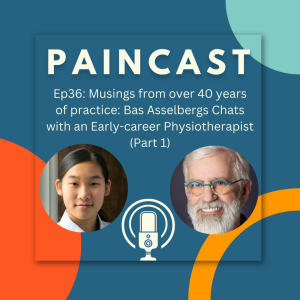
Friday Mar 21, 2025
Friday Mar 21, 2025
In this episode, we talked about:
How we can reinforce our own confirmation bias and how to break the cycle
What matters the most as physiotherapists
How your experiences as a physiotherapist drastically change as you shift your paradigm from a fixer mindset to a guide mindset
How Bas refined the art of connecting with patients over the years and help them understand pain science
Why is it of paramount importance that we help patient understand their pain
Graduated in 1983, Bas has extensive post-graduate experience in manual, exercise and movement focused therapies, sports physiotherapy and pain related education. He was a Mentor for post-graduate physiotherapists for the Pain Sciences Division of the Canadian Physiotherapy Association, and has been Team Therapist for the Junior National Figure Skating Team and the National Cross-Country Ski Team, and attended many National, World and Olympic competitions of a wide variety of sports. He has taught workshops in North America to Osteopaths, Medical Doctors and Physiotherapists since 1992. Sebastian will never stop learning. He enjoys his attempts at golf, loves travelling and being with friends and family.
Exploring Pain: Research and Meaning Facebook Group: https://www.facebook.com/groups/ExplainingPainScience
Paincast is dedicated to bringing together researchers, clinicians, and students to discuss topics related to pain and physiotherapy. The primary purpose is to facilitate knowledge translation and critical thinking. Some episodes posit themselves as more educational than others, and some more opinionated than others. The listener is encouraged to listen critically. While there is an effort to incorporate research evidence, and the topics are always researched by the host, we recognize there is room for improvement and there is expertise in the community. As such, we invite constructive critique and that you inform us of any inadvertent errors, so that we may correct them. You may submit your feedback through this form: https://forms.gle/UFfbUHBh8uKwSKgS8
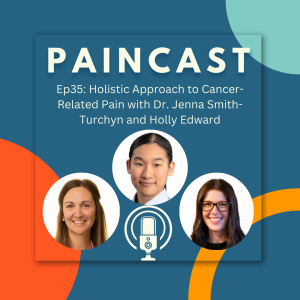
Monday Jan 20, 2025
Monday Jan 20, 2025
In this episode, we talked about:
Experiences of having cancer and cancer-related pain
The significance of physiotherapy in cancer rehab and managing cancer-related pain
Common misconceptions about physiotherapy for people living with or beyond cancer
How physiotherapists can consider the evidence of cancer rehab and the unique biopsychosocial realities of individuals when providing care
Jenna Smith-Turchyn, PT, PhD, is a physiotherapist and Assistant Professor in the School of Rehabilitation Science at McMaster University. She is also co-chair of the Canadian Physiotherapy Association’s Oncology Division. Jenna has an active research program at various cancer centres across Ontario. Her research focuses on cancer rehabilitation for individuals living with or beyond a cancer diagnosis, with the goal of maximizing participation and physical functioning.
Holly Edward is a physiotherapist and PhD Candidate working under the supervision of Dr. Jenna Smith-Turchyn at McMaster University. Holly's thesis project explores and evaluates the use of a physiotherapist-navigator role for individuals newly diagnosed with cancer. Holly's research promotes symptom assessment and management to be included in standard and routine cancer care in Canada to promote optimal physical function and improve the quality of life in individuals living with and beyond cancer. Holly is also a member of the executive of the Canadian Physiotherapy Association’s Oncology Division.
Resources
Canadian Physiotherapy Association Oncology Division website: https://www.oncologycpa.ca
Exercise Guidelines for Cancer Survivors (Campbell et al., 2019): https://pmc.ncbi.nlm.nih.gov/articles/PMC8576825/
Cancer Care Ontario Exercise Recommendations: https://www.cancercareontario.ca/sites/ccocancercare/files/ExerciseGuide.pdf
Prospective Surveillance Model (Stout et al., 2012): https://pubmed.ncbi.nlm.nih.gov/22488693/
Cancer Care Ontario Symptom Management Guide- Pain: https://www.cancercareontario.ca/en/system/files_force/symptoms/CCOPainFull.pdf?download=1
Website containing free resources to learn about oncology: https://www.learnoncology.ca/modules
Social Media handles
X and LinkedIn @SmithTurchyn
Instagram and LinkedIn @oncologyphysiotherapy @holly_edward
Paincast is dedicated to bringing together researchers, clinicians, and students to discuss topics related to pain and physiotherapy. The primary purpose is to facilitate knowledge translation and critical thinking. Some episodes posit themselves as more educational than others, and some more opinionated than others. The listener is encouraged to listen critically. While there is an effort to incorporate research evidence, and the topics are always researched by the host, we recognize there is room for improvement and there is expertise in the community. As such, we invite constructive critique and that you inform us of any inadvertent errors, so that we may correct them. You may submit your feedback through this form: https://forms.gle/UFfbUHBh8uKwSKgS8
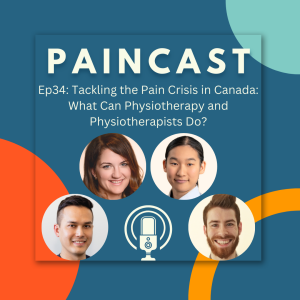
Friday Dec 06, 2024
Friday Dec 06, 2024
In this episode, we talked about
The past, present, and future of pain advocacy in Canada
The role of the professional association in supporting advocacy initiatives
The reception of physiotherapists' advocacy
The ripple effects of our pain advocacy efforts
Krissy Bell, CEO, Canadian Physiotherapy Association
Krissy Bell was appointed Chief Executive Officer of the Canadian Physiotherapy Association in March 2023. Since joining the association in 2019, she has been an essential member of the executive team, driving organizational growth over the past five years through various leadership roles. Krissy's career prior to her role at the association includes consulting for some of Canada's largest non-profits and charities, where she specialized in organizational problem-solving with a focus on business development and strategic planning. Before her consulting career, Krissy served for seven years as an Artillery Officer in the Canadian Forces, followed by diverse roles in business development, marketing, and event management within the sports sector. In addition to her professional experience, Krissy is actively involved in volunteer work, particularly in governance roles within the sports sector. She has served as a Board member for not-for-profit organizations for nearly twenty years, and is currently in her final term as Vice-Chair of Canada Snowboard, the national governing body for snowboarding in Canada. As a mother of two herself, Krissy is a passionate advocate for working mothers who champions women through the intentional development of working environments that support those who want to balance family life while advancing their careers.
Arthur Woznowski-Vu, PT, PhD
Arthur Woznowski-Vu has been a practicing physiotherapist since 2013. He has been teaching the Pain Management Strategies course at Concordia University since 2023, and has previous teaching experience at Université de Montréal and McGill University. Early in his career, Arthur focused on developing his physiotherapy expertise in chronic pain. He pursued several continuing education courses and then went on to complete a PhD in Rehab Science (focusing on chronic pain) at McGill University in 2023, receiving several prestigious scholarships (e.g., CIHR). As Chair of the Pain Science Division at the Canadian Physiotherapy Association (2021-2023), Arthur led several initiatives including a national physiotherapy advocacy in response to the Canadian Pain Task Force's Action Plan for Pain in Canada: https://physiotherapy.ca/advocacy-updates/national-physiotherapy-month-2023-4/. In 2023, Arthur opened The Chronic Pain Rehab Clinic as his solo physiotherapy private practice in Montreal: www.chronicpainrehab.ca.
Nathan Augeard, PT, MSc
Nathan Augeard has been a practicing physiotherapist since 2018, with a strong focus on chronic pain management. He is currently completing his PhD in Rehabilitation Science at McGill University, where his research focuses on improving pain management education in entry-level physiotherapy programs across Canada. Nathan has received several awards for his work, including the Ronald Melzack–Canadian Journal of Pain Paper of the Year Award. He has been actively involved in pain advocacy, serving as an executive member of the Pain Science Division of the Canadian Physiotherapy Association (2021-2023) and the current Director of the Working Group on Pain Advocacy. As the founder of Physio Connection (www.physioconnection.ca), a virtual physiotherapy service, Nathan is committed to enhancing access to evidence-based care for individuals living with chronic pain, especially in remote regions.
Resources
CPA Position Paper and other pain advocacy resources for physiotherapy professionals, bilingual: https://physiotherapy.ca/advocacy-updates/national-physiotherapy-month-2023-4/
3 reports from the Canadian Pain Task Force: https://www.canada.ca/en/health-canada/corporate/about-health-canada/public-engagement/external-advisory-bodies/canadian-pain-task-force.html
National action network that coordinates all pain-related organizations in Canada towards implementation of the Canadian Pain Task Force's Action Plan for Pain in Canada; and provides resources for public and professionals: https://www.paincanada.ca/
Summary on the illegal opioids crisis: https://www.canada.ca/en/health-canada/services/opioids/overdose-crisis-toxic-illegal-drug-supply.html
Campbell, F., et al (2024). Advancing Chronic Pain Care in Canada: History and Impact of the Canadian Pain Task Force. Canadian Journal of Pain, 2358332.
Paincast is dedicated to bringing together researchers, clinicians, and students to discuss topics related to pain and physiotherapy. The primary purpose is to facilitate knowledge translation and critical thinking. Some episodes posit themselves as more educational than others, and some more opinionated than others. The listener is encouraged to listen critically. While there is an effort to incorporate research evidence, and the topics are always researched by the host, we recognize there is room for improvement and there is expertise in the community. As such, we invite constructive critique and that you inform us of any inadvertent errors, so that we may correct them. You may submit your feedback through this form: https://forms.gle/UFfbUHBh8uKwSKgS8
Follow Paincast on Instagram: https://www.instagram.com/paincast.psd/
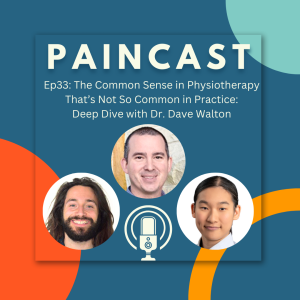
Sunday Nov 17, 2024
Sunday Nov 17, 2024
In this episode, we talked about
Using the Assess, Predict, Treat framework to direct our patient care
The radar plot, triangulation, arms-length approach, and phenotyping
Correlation and causation; confounders, moderators, and mediators
The significance and practical tips of practicing trauma-assumed care
Professor Walton is a clinical researcher who focuses on the intersection between trauma, pain, physical and mental health. He uses both quantitative and qualitative approaches to explore these phenomena, and engage in critical theory around measurement of pain, wellness, and other clinical outcomes to enrich the rehabilitation and life experiences of people living with pain. He was one of the pioneers in Canada in the area of Pain Science in Physiotherapy, and was one of the co-founding members of the Pain Science Division of the Canadian Physiotherapy Association. He co-authored Musculoskeletal Pain---Assessment, Prediction, and Treatment, A Pragmatic Approach with Dr. James Elliott, which is the textbook we will be discussing in the episode.
Resources
Walton, D., & Elliott, J. (2020). Musculoskeletal Pain-Assessment, Prediction and Treatment. Jessica Kingsley Publishers.
Lee, J. Y., et al. (2020). Defining pain and interference recovery trajectories after acute non-catastrophic musculoskeletal trauma through growth mixture modeling. BMC Musculoskeletal Disorders, 21, 1-11.
Walton, D. M., Tremblay, P., Seo, W., Elliott, J. M., Ghodrati, M., May, C., & MacDermid, J. C. (2021). Effects of childhood trauma on pain‐related distress in adults. European Journal of Pain, 25(10), 2166-2176.
Elliott, J. M. et al. (2023). Biopsychosocial sequelae and recovery trajectories from whiplash injury following a motor vehicle collision. The Spine Journal, 23(7), 1028-1036
Paincast is dedicated to bringing together researchers, clinicians, and students to discuss topics related to pain and physiotherapy. The primary purpose is to facilitate knowledge translation and critical thinking. Some episodes posit themselves as more educational than others, and some more opinionated than others. The listener is encouraged to listen critically. While there is an effort to incorporate research evidence, and the topics are always researched by the host, we recognize there is room for improvement and there is expertise in the community. As such, we invite constructive critique and that you inform us of any inadvertent errors, so that we may correct them. You may submit your feedback through this form: https://forms.gle/UFfbUHBh8uKwSKgS8
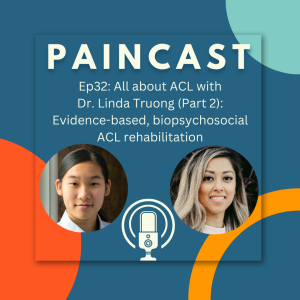
Friday Nov 08, 2024
Friday Nov 08, 2024
In this episode, we talked about
What is good ACL rehab?
What are the psychological, social, and contextual factors influencing ACL rehab outcomes, and what can we do about them?
What about ACL healing and Cross Bracing Protocol?
Clinician-Scientist | Physical Therapist | Post-doctoral Fellow
Expertise and research focus:
Qualitative research
Mixed methods research
Musculoskeletal (MSK) and sports rehabilitation
Digital health implementation
Models of care in rehabilitation
Current Focus: Postdoctoral research on innovative care models and the integration of digital health solutions for MSK pain management.
My work bridges the gap between clinical practice and digital health technology, aiming to improve patient outcomes through evidence-informed strategies. My clinical expertise lies in management and treatment of traumatic knee injuries (e.g., ACL injuries). I currently work part time at a local physiotherapy clinic and teach within the Master of Physical Therapy program at the University of British Columbia in Vancouver Canada.
Resources
Kotsifaki, R., Korakakis, V., King, E., Barbosa, O., Maree, D., Pantouveris, M., ... & Whiteley, R. (2023). Aspetar clinical practice guideline on rehabilitation after anterior cruciate ligament reconstruction. British journal of sports medicine, 57(9), 500-514.
Whittaker, J. L., Culvenor, A. G., Juhl, C. B., Berg, B., Bricca, A., Filbay, S. R., ... & Crossley, K. M. (2022). OPTIKNEE 2022: consensus recommendations to optimise knee health after traumatic knee injury to prevent osteoarthritis. British journal of sports medicine, 56(24), 1393-1405.
Article on non-surgical ACL rehab: https://www.physio-network.com/blog/growing-evidence-non-surgical-acl/
Podcast on group rehab ACL https://podcasts.apple.com/dk/podcast/ep-41-life-in-the-fast-lane-with-linda-truong-christina-le/id1522929437?i=1000526250993
Podcast on social and contextual factors https://bjsmbmj.podbean.com/e/taking-the-social-and-contextual-seriously-in-sports-medicine-with-linda-truong-ep-469/
ACL rehab criteria: https://www.melbourneaclguide.com/docs/ACL_Guide.pdf
Social media connection
X @LKTphysio
Instagram @lint.fit IG
Paincast is dedicated to bringing together researchers, clinicians, and students to discuss topics related to pain and physiotherapy. The primary purpose is to facilitate knowledge translation and critical thinking. Some episodes posit themselves as more educational than others, and some more opinionated than others. The listener is encouraged to listen critically. While there is an effort to incorporate research evidence, and the topics are always researched by the host, we recognize there is room for improvement and there is expertise in the community. As such, we invite constructive critique and that you inform us of any inadvertent errors, so that we may correct them. You may submit your feedback through this form: https://forms.gle/UFfbUHBh8uKwSKgS8
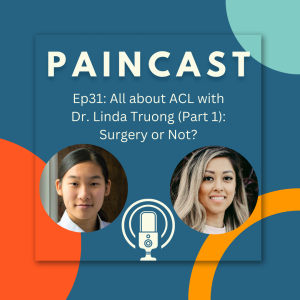
Saturday Oct 19, 2024
Saturday Oct 19, 2024
In this episode, we talked about
Different options after an ACL tear
What the current body of evidence say about the outcomes of different options
Clarifying research terminologies: statistical vs clinical significance, levels of certainty, what constitute good research
Clinician-Scientist | Physical Therapist | Post-doctoral Fellow
Expertise and research focus:
Qualitative research
Mixed methods research
Musculoskeletal (MSK) and sports rehabilitation
Digital health implementation
Models of care in rehabilitation
Current Focus: Postdoctoral research on innovative care models and the integration of digital health solutions for MSK pain management. My work bridges the gap between clinical practice and digital health technology, aiming to improve patient outcomes through evidence-informed strategies. My clinical expertise lies in management and treatment of traumatic knee injuries (e.g., ACL injuries). I currently work part time at a local physiotherapy clinic and teach within the Master of Physical Therapy program at the University of British Columbia in Vancouver Canada.
Resources
Owen, P., et al. (2023). Infographic. Primary surgery versus primary rehabilitation for treating anterior cruciate ligament injuries. British Journal of Sports Medicine, 57(13), 882-883.
Saueressig, T., et al. (2022). Primary surgery versus primary rehabilitation for treating anterior cruciate ligament injuries: a living systematic review and meta-analysis. British journal of sports medicine, 56(21), 1241-1251.
Beard, D. J., et al. & ACL SNNAP Study Group. (2024). Comparison of surgical or non-surgical management for non-acute anterior cruciate ligament injury: the ACL SNNAP RCT. Health technology assessment (Winchester, England), 28(27), 1.
Culvenor, A. G.,et al. (2022). Rehabilitation after anterior cruciate ligament and meniscal injuries: a best-evidence synthesis of systematic reviews for the OPTIKNEE consensus. British journal of sports medicine, 56(24), 1445-1453.
Beard, D. J., et al. (2022). Rehabilitation versus surgical reconstruction for non-acute anterior cruciate ligament injury (ACL SNNAP): a pragmatic randomised controlled trial. The Lancet, 400(10352), 605-615.
Frobell, R. B., et al. (2010). A randomized trial of treatment for acute anterior cruciate ligament tears. New England Journal of Medicine, 363(4), 331-342.
Reijman, M., et al. (2021). Early surgical reconstruction versus rehabilitation with elective delayed reconstruction for patients with anterior cruciate ligament rupture: COMPARE randomised controlled trial. Bmj, 372.
Whittaker, J. L., et al. (2022). OPTIKNEE 2022: consensus recommendations to optimise knee health after traumatic knee injury to prevent osteoarthritis. British journal of sports medicine, 56(24), 1393-1405.
Kamper, S. J. (2019). Interpreting outcomes 2—statistical significance and clinical meaningfulness: linking evidence to practice. journal of orthopaedic & sports physical therapy, 49(7), 559-560.
Kamper, S. J. (2019). Interpreting outcomes 3—clinical meaningfulness: linking evidence to practice. journal of orthopaedic & sports physical therapy, 49(9), 677-678.
Social media connection
X @LKTphysio
Instagram @lint.fit
Paincast is dedicated to bringing together researchers, clinicians, and students to discuss topics related to pain and physiotherapy. The primary purpose is to facilitate knowledge translation and critical thinking. Some episodes posit themselves as more educational than others, and some more opinionated than others. The listener is encouraged to listen critically. While there is an effort to incorporate research evidence, and the topics are always researched by the host, we recognize there is room for improvement and there is expertise in the community. As such, we invite constructive critique and that you inform us of any inadvertent errors, so that we may correct them. You may submit your feedback through this form: https://forms.gle/UFfbUHBh8uKwSKgS8


